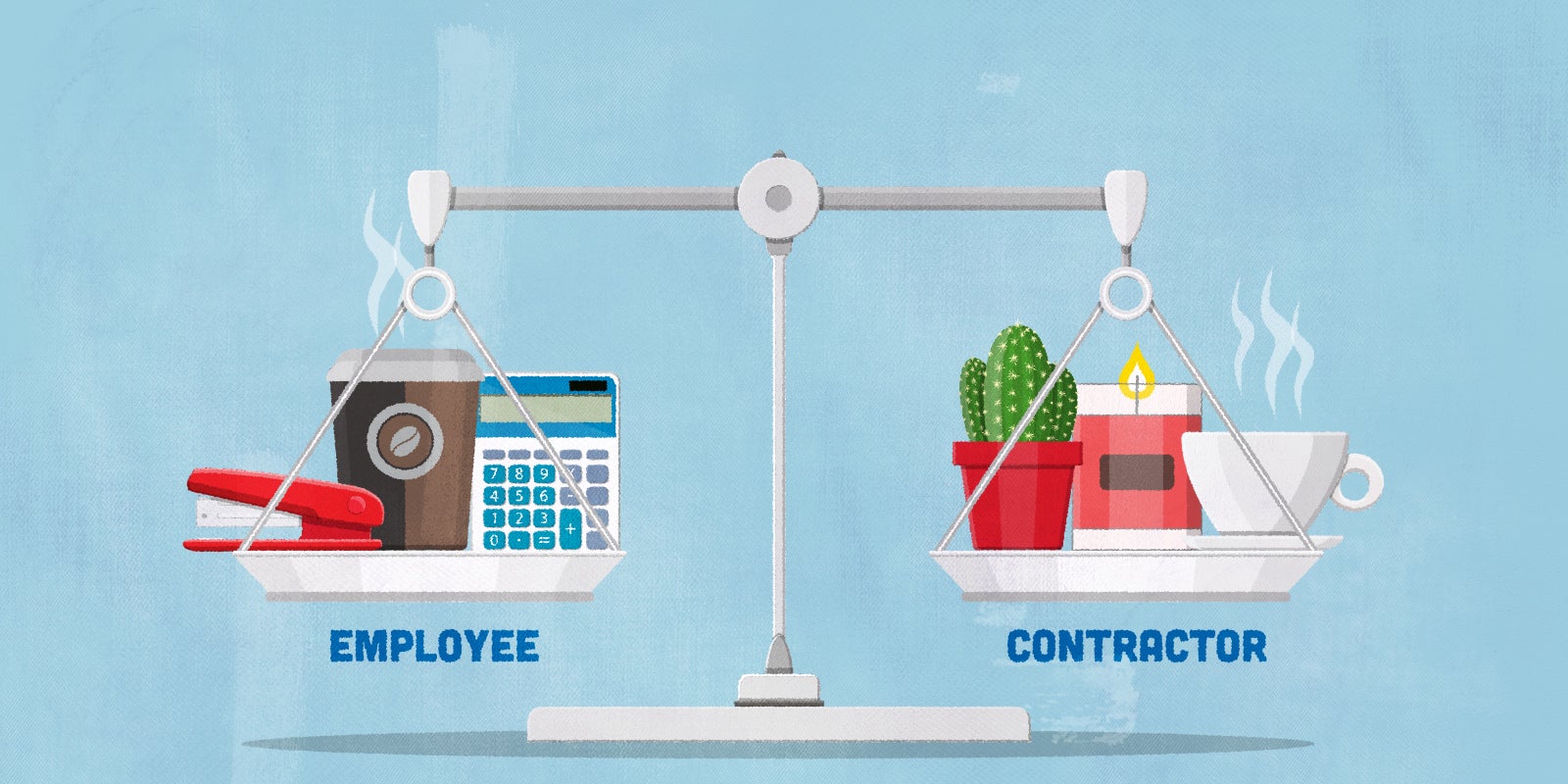Contractor vs Employee: A Mini Guide for American Small Businesses
By: Wagepoint

This post is about employees and contractors in the United States. For the Canadian version, click here.
Table of contents/quick links
Self-employment trends
Determining worker employment status
Request a ruling
Employees vs. contractors — the “benefits” and “drawbacks”
Tax benefits
Can a contractor become an employee or vice versa?
Paying employees and contractors
Consequences of misclassifying workers
Hiring an employee or contractor is exciting — it means your small business is growing! Regardless of who you hire, you need to properly define the working relationship. You need to know what classifies someone as an employee or contractor and which of those factors makes the most sense in terms of your business needs and the needs of the person or people you’re hiring.
Before we dive into the difference between an employee and a contractor, we’ll first provide a quick overview of the changing employment landscape.
Self-employment and the modern labor market
28% of the US labor market consists of full-time freelancers – a jump from 17% in the past decade.
The rise clearly indicates that the “shift to independent white-collar work” is here to stay and brings to light one thing every employer should know — the difference between a traditional employee and a contractor.
Why is being self-employed so enticing?
More and more workers, especially those in professional, scientific and technical services, have chosen to be independent contractors. Many of these individuals state that they’ve chosen this route because it gives them more freedom and independence in how and when they work.
Another factor to consider in self-employment — the nature of the work.
Industries like marketing and advertising often work on a contract basis with a majority of their clients. That’s the nature of their industry. Many businesses, especially small businesses, don’t need a full-time human resources (HR) team or specialized service, which is why it makes sense to contract for these needs.
Conversely, a small business itself needs to consider the industry in which it operates and the role it’s trying to fill to determine if it needs an employee or a contractor. For example, if you’re running a cafe, it’s likely that you don’t need a freelance barista.
The gig economy — what on earth is that?
Since companies like Uber and Lyft (also known as gig economy giants) have entered the scene, there’s no question that the American labor market has changed. Both companies have built their models around self-employed drivers who work at will. However, there have been several legal challenges to this because the line between what constitutes as an employee and a contractor is quite thin.
The growing rate of remote work.
Remote work or working from home is another trend that shows no sign of slowing down. According to recent research, 4.3 million people in the US work from home at least half of the time.
While these workers can either be employees or contractors, the point is that with technology, people can work from almost anywhere.
How the difference between an employee and a contractor affects small businesses.
With self-employed workers now growing in an upward trajectory, every business is faced with the question: “Do I hire an employee or contractor?”
This also goes hand-in-hand with Millennials starting their careers as a result of fewer traditional job opportunities, and newly unemployed and skilled middle-aged workers making a career shift into self-employment.
Small businesses and startups can certainly reap the benefits of self-employment. Depending on the job role, small businesses can employ contractors more easily than employees, subsequently lowering their burn rate.
Classification is key.
There’s a strong market backlash against employing contractors when they are actually employees. This is called “misclassification”.
Cases against FedEx and Uber and the introduction of Assembly Bill 5 (AB 5) in California, are clear indicators that the government won’t put up with small businesses that hope to get away with willful misclassification.
Determining worker employment status
Don’t be ashamed if you don’t know the answer off the top of your head. It’s a question that trips up even some of the most experienced business owners.
As a starting point, it’s best to consult the Internal Revenue Service (IRS)’s Publication 15-A, Employer’s Supplemental Tax Guide, but ultimately, it all boils down to one question: who is dictating the terms of the relationship?
Formally, the IRS looks at who has a higher degree of control and independence. In the IRS’ eyes, whoever the winner is between the worker and business owner determines whether you’re working with a contractor or employee.
Facts that provide evidence of the degree of control and independence fall into three categories:
-
Behavioral factors: Does your business control what the worker does and how the worker does his/her job?
-
Financial factors: Are the business aspects of the worker’s job controlled by you? These include things like how the worker is paid, whether expenses are reimbursed, who provides the tools/supplies, etc.
-
Type of relationship: Are there written contracts or employee type benefits (pension plan, insurance, vacation pay, etc.)?
The key is to look at the entire relationship, consider the degree or extent of the right to direct and control.
Here’s a table that showcases the differences between the two types of workers:
Help in determining worker status
If there’s still any confusion or concerns, you can get a ruling from the government directly. Complete Form SS-8, Determination of Worker Status for Purposes of Federal Employment Taxes and Income Tax Withholding and wait for their response. Keep in mind that it can take up to six months to hear back from the IRS.
What is the California Assembly Bill 5 (AB 5)?
Small business owners from California have another tool in their employer toolbox: the Assembly Bill 5 (AB 5).
AB 5 is a legislation that was passed in California and came into effect in early 2020. Informally known as the “gig-economy bill”, it seeks to force companies—especially the gig economy giants—to treat more of their workforce as employees.
AB 5 requires the application of the “ABC test” to determine if workers in California are employees or contractors for purposes of the Labor Code, the Unemployment Insurance Code, and the Industrial Welfare Commission (IWC) wage orders.
If an employer is found to be voluntarily misclassifying employees as contractors, there are penalties that may be assessed for wage violations and civil penalties. Under Labor Code section 226.8, the civil penalties range between $5,000 and $25,000 per violation.
Employees vs. contractors — the “benefits” and “drawbacks”
In this section, we’ll discuss the benefits and drawbacks of each option. Every business is different, so we’re putting the terms in quotations. A benefit for one business might be a drawback for another and vice versa.
The “benefits” of hiring employees:
-
More oversight on deliverables. Employers are able to guide and supervise the work outcome using management techniques, workplace guidelines and key performance indicators (KPIs) thus ensuring work is done as planned, regardless of the volume of work.
-
More cost-effective (on an hourly basis). Depending on the type of skill required, they are more cost-effective on an hourly basis, as a result of supply-demand factors influencing less specialist skills in the market.
-
Better employer-employee relationship management. Maintaining employer-employee relationships is generally easier for employers, compared to client-contractor relations, due to the control factor and ability to measure work outputs more easily. Working in the same office is also beneficial for both parties.
The “drawbacks” of hiring employees:
-
Greater need for employee management. This means an increased need for strict processes and KPIs in order to manage employees. Employers are also responsible for all in-house training and the associated costs.
-
More financial and legal responsibilities. Salary costs, including all withholdings, employment taxes and other payments due to the Federal government, agencies and state/local government are payable by the employer.
-
Smaller talent pool. Depending on the role, skills and seniority, the talent pool can be limited to the locality the business operates. Even where talent is plentiful, there’s usually a talent war amongst competitors and thereby impacting an employer’s ability to find top talent.
The “benefits” of hiring contractors:
-
Less time and money invested. Employers don’t need to invest in equipment, office space or any capital outlays as that is the contractor’s responsibility. Additionally, self-employed workers are also responsible for their own training in order to have the right skills.
-
No tax obligations. All taxes are paid and reported by the contractor, either as an individual, an incorporated business or a mix of the two.
-
Greater access to a network with specialized skills. It can be easier for companies to find specialist skills at a more cost-effective price from a contractor than an employee, especially if that contractor is not needed at a comparable rate to full-time hours.
-
Flexible work arrangements. The relationship can expand and contract depending on the needs of the client, and contractors can subcontract out other aspects of work. This makes it easier for the client to receive a wider range of services while only working with a single provider. Additionally, both parties are free to cancel the working relationship, depending on the terms of the contract.
The “drawbacks” of hiring contractors:
-
No tax deductions. Clients (employers) can’t deduct any of those expenditures off their corporate tax bills.
-
Not always readily available. In an ideal world, contractors would be at your beck and call — but they’re not. Since contractors are an independent business at their own right, they may already be working with a new client meaning they might not have the capacity to take on your projects.
-
There’s no such thing as a conflict of interest. Self-employed workers need to look for clients. Subsequently, they may contact your competitor when their services aren’t needed. And vice versa – contractor can’t always take on new clients due to capacity limitations.
-
No control over the work schedule. It’s not always possible to have deliverables completed exactly on your preferred timelines. Contractors have other clients and are, therefore, free to set their own working schedule within reason.
The respective tax benefits of employees and contractors
As Benjamin Franklin famously stated, “In this world, nothing can be said to be certain, except death and taxes.” And it’s true — where there’s work, there are taxes. Each type of worker comes with their own tax benefits. We highlight them below:
Tax benefits of hiring employees:
-
Work Opportunity Tax Credit (WOTC) allows companies to hire certain specific groups, like veterans and claim the tax credit as a general business credit against their income tax.
-
The Americans with Disabilities Act (ACA) allows for tax credits when employers hire people with disabilities, provided all legal requirements are met.
-
The Hiring Incentives to Restore Employment (HIRE) Act gives tax breaks to employers when they hire certain previously unemployed workers (“qualified employees”).
Tax benefits of hiring contractors:
There are no direct (government-funded) tax breaks for hiring contractors, except that the employer is absolved from the responsibility of paying federal, state and local taxes. That makes hiring contractors a financially viable alternative for many companies, provided the correct client-contractor relationship is maintained.
Can a contractor become an employee or vice versa?
Yes, but… moving from contractor status to being classified as an employee isn’t automatic. No matter how long the duration — say, one year or even five years — if the contractual and practical terms of the contract of service remain much as it was when the contract was entered into, the contractor does not become an employee after a certain amount of time.
That said, it isn’t unusual for someone to start as a contractor but are then hired as an employee. The flip side is also common. For several reasons, people who started as employees may choose to work as a contractor down the road.
How does a contractor become an employee? You’ll have to formally update the original contract to reflect the new status. That means modifying the agreement from a “contract for services” to “contract of service” or vice versa.
Switching from contractor to employee.
Making the switch will require you to go through the normal procedures of hiring — including asking them to fill out Form I-9, Employment Eligibility Verification, Form W-4, Employee’s Withholding Certificate and other traditional employment documents.
As well, you’ll need to understand how the nature of the relationship will change once a worker becomes an employee after being a contractor. Some things to consider are:
- Tax responsibilities. You’ll now be responsible for deducting payroll taxes from the employee’s paycheck, including Federal income tax withholding, Medicare and Social Security, and sending those amounts to the IRS.
- Benefits. Most employees will expect basic benefits such as health insurance and vacation pay. Knowing this, you’ll likely be including the worker in your benefits plan.
- Employee handbooks. Usually, business owners provide their employees an employee handbook. It sets clear expectations for them, highlights your legal obligations and defines employee rights. It’ll also help protect your business against employee lawsuits and claims.
Paying employees and contractors
A good understanding of the difference between an employee and contractor is important — and so is using software that can recognize the difference. Paying employees and contractors can be confusing since they’re not one and the same. Working with payroll software that has these capabilities will help simplify the payroll process — you’ll be able to skip paying the payroll taxes or apply them easily.
Consequences of misclassifying workers
Unintentionally classifying an employee as a contractor will result in some financial liability (if an IRS Form 1099 has been filed): generally 1.5% of the salary of the federal income tax withholding amount, plus 20% of FICA taxes paid by the employee, plus all of what the employer should have paid.
However, if Form 1099 hasn’t been sent in, but it is still unintentional, the IRS would double the amounts – 3% of withholding taxes, 40% of FICA taxes, plus the employer’s contribution to FICA.
The penalties of intentional misclassification.
The IRS is very clear when it comes to intentional misclassification: “If you classify an employee as an independent contractor and you have no reasonable basis for doing so, you may be held liable for employment taxes for that worker.”
All of the employment taxes would be due, all of FICA (unless the “employee” paid some of those taxes, which offsets the cost), plus penalties in many multiples of the percentages of taxes withheld, plus potentially civil and criminal liability charges.
If you don’t employ anyone as a staffer doing a similar role to a self-employed worker and have appropriate justification for using a contractor and not an employee then it might be possible to get relief from federal employment tax obligations under Section 530.
According to Section 530 of the Revenue Act of 1978, there is a reasonable basis (known as a safe harbor) for an employer misclassifying a worker, if the following criteria are met:
-
Judicial precedent, published rulings or technical advice with respect to the taxpayer;
-
A past IRS audit in which there was no employment tax assessment attributable to the treatment of the individuals holding positions substantially similar; or
-
A long-standing recognized practice of a significant segment of the industry in which such individual was engaged.
There must also be a precedent within the company, previous business, or sector for those types of workers to be treated as contractors, and the employer must have filled out Form 1099 MISC (Miscellaneous Income) for each worker, if such form was required.
Make the best choice for your small business
The hard part isn’t finding talent — it’s finding the right type of talent. In order to make the best hiring choice, all small business owners must understand the differences between employees and self-employed workers. No matter which option you choose, remember that misclassifying your workers can be a costly mistake. And when you need to pay these workers, you’ll need payroll software that can also tell the difference between employees and contractors.
The advice we share on our blog is intended to be informational. It does not replace the expertise of accredited business professionals.
Author: Mel is a Content Specialist at Wagepoint with a keen interest in Wellness, People & Culture and the Employee Experience. When she isn’t writing, she spends her time sipping on lattes, inhaling banana cream pies, studying into different personality frameworks (her MBTI: ESFP), and pestering her partner.












